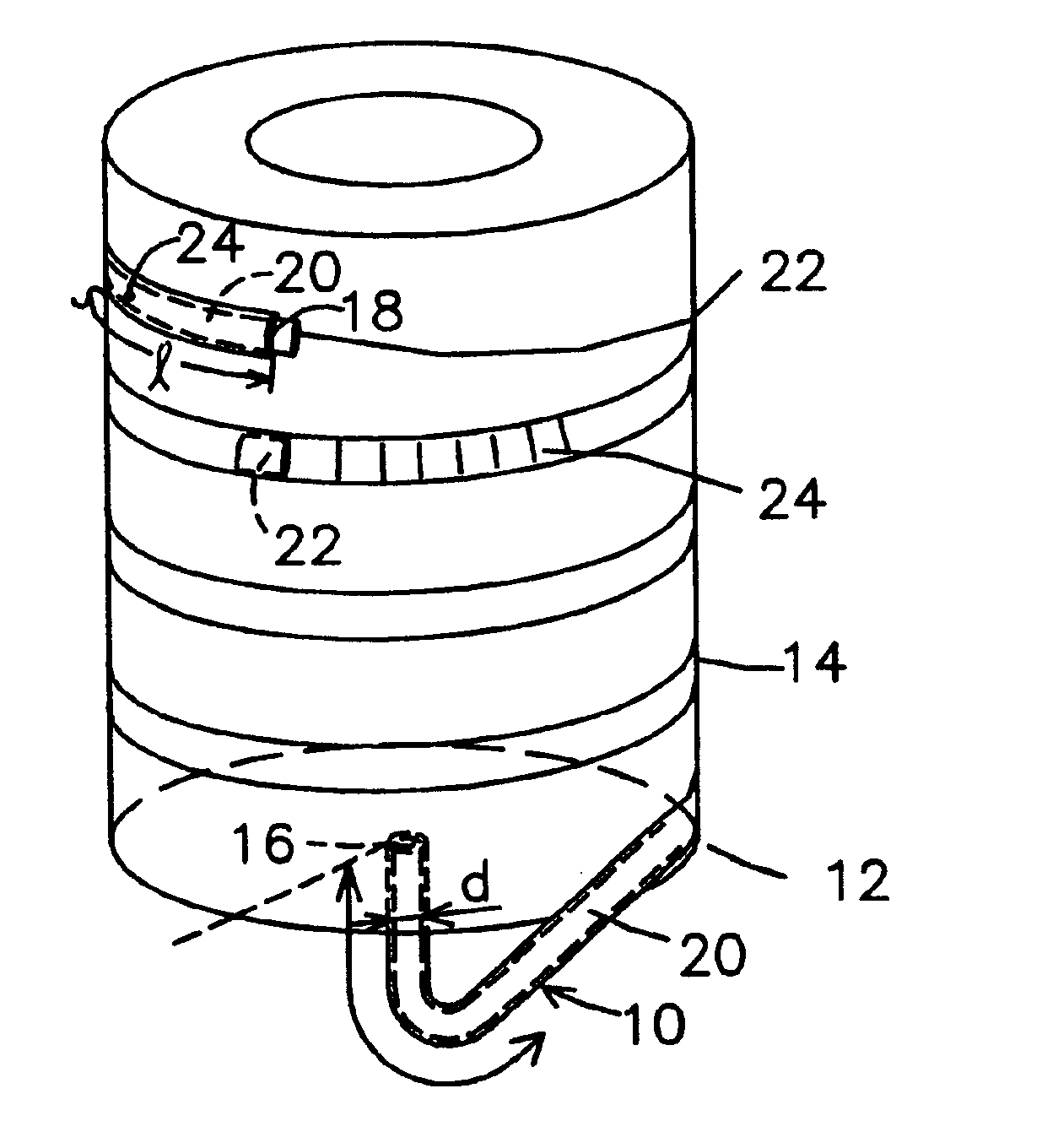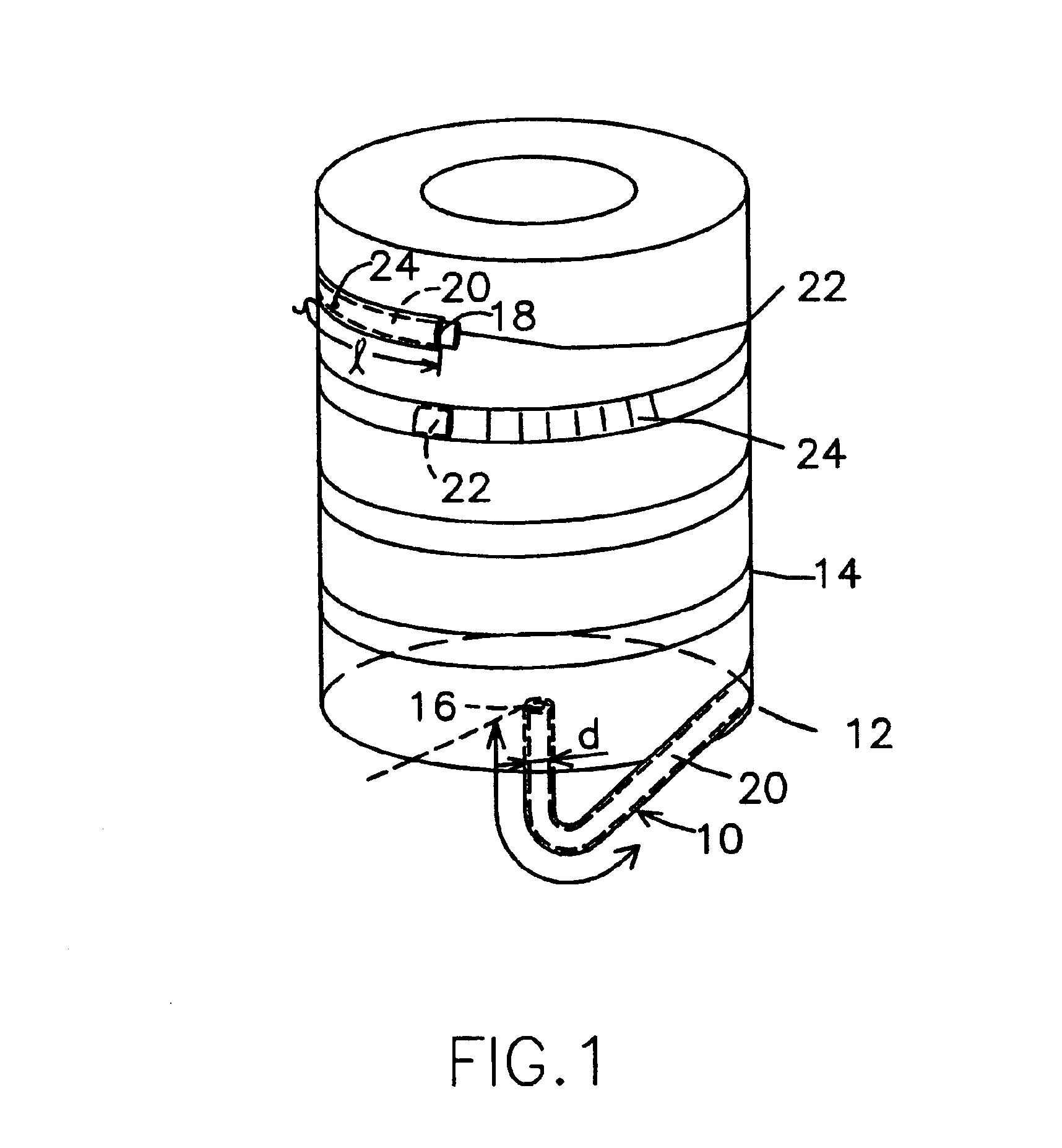[0010]To prevent the ingress of air into a dispensing pump, in a first embodiment of the invention, a sealed dip tube is provided to replace the liquid reservoir of a dispensing pump. In particular, a dip tube having an elongated member with two ends and an inner passage extending therebetween is provided, in which a liquid supply for the dispensing pump is disposed in the passage. A sealing plug is located in the passage so as to prevent the ingress of air into the liquid. In a preferred embodiment, the sealing plug is slidable in the passage, so as liquid is drawn from the passage, the plug slides behind the liquid as it is drawn and reduces the volume of the passage that is in communication with the dispensing pump. With the arrangement of the first embodiment, the dip tube takes the place of the reservoir, and reduces the likelihood of ingress of air into the pump.
[0012]In a third embodiment of the invention, a liquid reservoir is provided which is preferably cup-shaped with a base and an upstanding side wall. A recess is defined in the base of the reservoir, into which an inlet end of a dip tube extends. The dip tube serves to communicate liquid accommodated in the recess with a dispensing pump. Additionally, a semi-permeable membrane extends across the recess. With the dispensing pump in a gravitationally upright position, liquid contained in the reservoir seeps through the membrane to flood the recess. Upon actuation of the dispensing pump, liquid is drawn through the dip tube from the recess. If the dispensing pump is held in a non-upright position, the semi-permeable membrane restricts flow of the liquid out of the recess—albeit the restriction is not absolute, and liquid eventually seeps through the membrane. The restriction of the semi-permeable membrane, however, makes available a liquid supply for a
dose of liquid to be administered by the dispensing pump, with the dispensing pump having any orientation, although the supply will be maintained for a limited time (i.e., before all of the liquid seeps out of the recess). With this arrangement, a volume of liquid is maintained, at least for a limited time, about the inlet end of the dip tube in any orientation of the dispensing pump, so as to limit the ingress of air into the dispensing pump.
[0013]A safety is provided as a fourth embodiment of the invention. In U.S. Pat. No. 5,881,596, a gravity sensitive failsafe mechanism is disclosed in which a dispensing cap and an
actuator coact to prevent actuation of the pump with the discharge aperture being oriented outside a predetermined
angular range of operation. Although this arrangement is very effective, the inclusion of the
actuator as an additional
structural element in a dispensing pump may not be desired. With the fourth embodiment of the subject invention, the safety comprises a safety ball; a blind aperture formed in the underside of a
nozzle cap with the blind aperture preferably facing in the actuation direction; and, a conical depression partially in registration with the blind aperture that is defined in the dispensing pump body. The safety ball is disposed in the conical depression, and the conical depression is formed such that when a discharge aperture defined in the
nozzle cap is oriented beyond a predetermined
angular range of operation, the safety ball is urged out of registration with the blind aperture, and when the discharge aperture is oriented within the predetermined angular range of operation, the safety ball is urged into registration with the blind aperture. Where the safety ball is out of registration with the blind aperture, the safety ball prevents depression of the nozzle cap; conversely, where, the safety ball is in registration with the blind aperture, the nozzle cap may be depressed with the safety ball being received within the blind aperture. The predetermined angular range of operation is selected to increase the likelihood that the inlet end of a dip tube is submerged in liquid in a reservoir of the dispensing pump.
[0014]In a fifth embodiment of the invention, a dispensing pump is formed having a pump cylinder disposed partially within a reservoir, with an inlet end of the pump cylinder being in close proximity to the base of the reservoir. The inlet end of the pump cylinder includes an inlet opening which communicates the pump cylinder with liquid contained in the reservoir. No dip tube is used. By locating the inlet end of the pump cylinder in proximity to the base,
capillary action of the liquid causes liquid to be drawn to the inlet end / reservoir base interface. To enhance the drawing process, the inlet end may be partially concavely curved away from the base, wherein the concavely curved portion is provided to encourage liquid at the base to feed the pump cylinder equally from all sides. It is also preferred that the pump cylinder be disposed in proximity to a portion of the side wall of the reservoir, and, specifically in proximity to the portion of the side wall located most proximally to the discharge aperture of the dispensing pump. In this manner, the tendency of a party to tilt the dispensing pump forwardly during use is taken
advantage of in feeding liquid to the pump cylinder. Also, the pump cylinder / side wall interface allows for
capillary action to draw fluid therein. With the dispensing pump in a non-upright position, this capillary action will cause liquid to be drawn up the pump cylinder and to the inlet end thereof. The
elimination of the dip tube, and the reliance on capillary action, reduces the likelihood of air being introduced into the dispensing pump.
[0016]In a seventh embodiment of the invention, a mirrored
label is disposed about a discharge aperture of a dispensing pump. The mirrored
label facilitates alignment of a portion of an eye, that is to receive a dose of liquid, with the discharge aperture of a dispensing pump.
 Login to View More
Login to View More  Login to View More
Login to View More 


